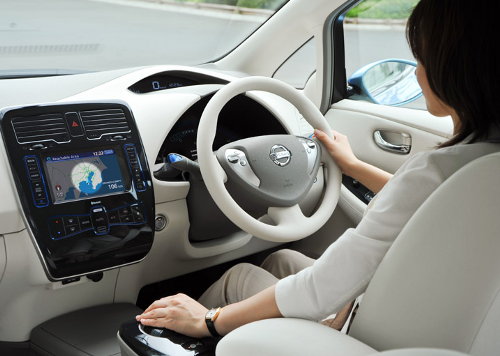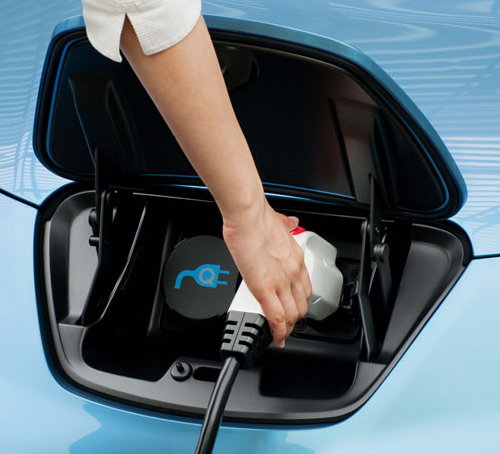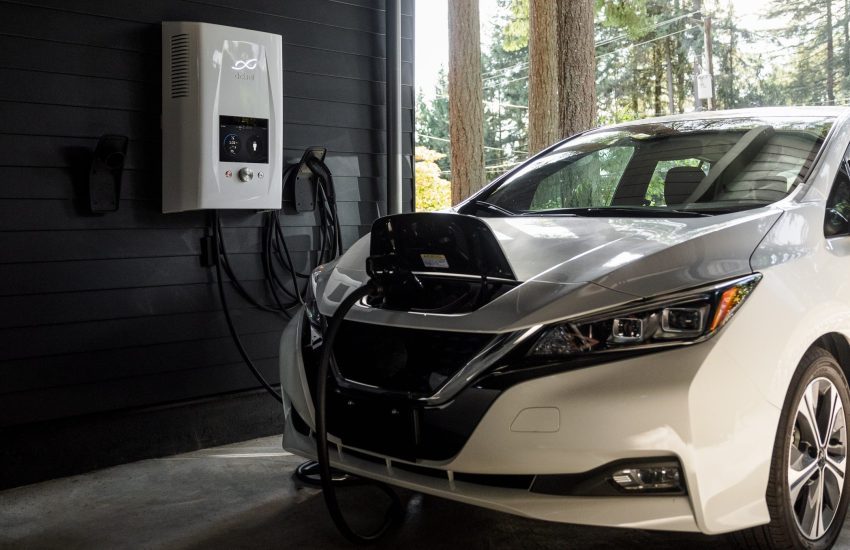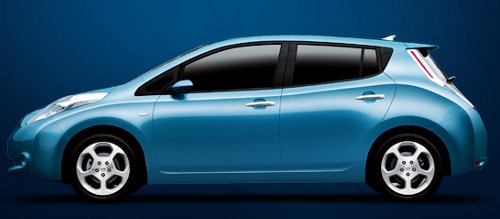Nissan LEAF – look Ma, no emissions!

A relative newcomer to the field of environmentally friendly cars, Nissan does not yet have a production vehicle based on it’s own hybrid technology. Nissan Altima Hybrid is based on Toyota Camry’s Hybrid Synergy Drive. However, with the North American debut of the Nissan LEAF car at upcoming LA Auto Show , Nissan appears to be trying to jump a step ahead of everybody else: LEAF has no gasoline engine! And LEAF is no golf cart, either. Keep reading for more details.
Nissan LEAF is a medium-sized five-door five passenger hatchback with an all-electric drivetrain that has one very big advantage over most other EV vehicles in its class – it is not a concept. The vehicle shown on the LA show floor is essentially the same vehicle that is going to, according to Nissan, hit the Nissan dealerships “in some states” (read: California) some time in 2010 with general availability slated for 2012.

LEAF sports an 80kW (107hp) electrical motor with mighty 280Nm (206 lb-ft) of torque connected to a Li-ion battery pack that, unlike Prius’es batteries, located underneath the cabin floor, not behind the back seats. The car is said to handle and accelerate (thanks to the electrical motor torque profile) as a V6 car and gets its top speed capped at 90mph.
Being an electric car, one obvious performance characteristic that everyone is concerned about it the single charge drive range. Nissan says the car is expected to get 100 miles range on a single charge, augmented by regenerative braking. This is where a common sense disclaimer is in order: your mileage will vary based on a great number of parameters, one of the most important of which is your driving habits. All the normal economy driving techniques will still apply to the EV – do not speed, accelerate and break slowly, keep your tire pressure optimal, all the usual stuff.

Once you’ve run out of juice, you will be able to recharge in 4-8 hours, depending on depleted the battery bank is, from a charging station device (dubbed EVSE and sold by Nissan separately, as far as I can understand) that hooks up to your 220V outlet shared with electrical dryer, water heater and other large electrical appliances. I would say now is the great time to talk to your electric utility company about upgrading your service, possibly even including an off-peak circuit for large appliances. Our hopes are that smart grid upgrades that the government is funding from the Recovery Act money would allow the utility companies to become more flexible with their rates and sell the electricity for charging cars at a lower rate, off-peak or not.
Given that the (current lack of) the charging infrastructure will make or break a mass-produced EV car, Nissan is said to work with utility companies on some framework that would allow creation of such charging stations. No details of the framework are available as of this writing and it may very well be just that – “memorandum of understanding” – but the utility companies stand to benefit greatly if they jump into the RV bandwagon quickly and if – a billion dollar if – electrical cars catch on this time around.
Hundred years ago electric utility companies (themselves in infancy at the time off course) were instrumental in promoting electrical vehicles which were seen as the major consumer of electricity in households. But, as the adoption of EVs stalled and other high power electrical appliances became easier to sell (think refrigerators and hair driers) , utilities have gradually abandoned any plans of developing the charging stations network which was the last nail in the coffin of the EV circa 1900s.

We are in a much different place now: unlike in the early 1900s most people do in fact have high power circuit coming into the household. Some may require panel upgrades and new wiring to a convenient charging location (garage or carport) but most of the infrastructure for private charging is ready.
There are still hurdles to overcome in terms of public charging stations but I believe that as EVs become more visible on the roads, businesses such as grocery stores, malls, movie theaters, restaurants and such may become interested in getting into the charging business by offering charging stalls in their parking lots. And what better way to ensure that the customer does not leave the premises than the fact that their vehicle is still charging! So, I believe electrical vehicles do have a chance this time around and kudos to Nissan for spearheading the efforts!
I did not mention one not-insignificant question: how affordable Nissan LEAF is going to be? It is really hard to say – Nissan is avoiding stating any particular price – but it is rumored to cost about $30,000. Provided that there will be at least some competition in the EV segment (Tesla Model S, price reduced?) and there is progress in creating the charging infrastructure, the price will not be too far out of reach of most people, at least most people driving Priuses now. Also, if Nissan is able to partner with some financial institution and innovate, they can sell the car and the battery bank as separate entities, much like the makers of the electrical vehicles in early 1910s did. The battery is a huge chunk of the cars cost and it may require some additional maintenance and eventual replacement, therefore a business case was wound 100 years ago to sell the car to the consumer while leasing the battery bank installed in it.
Great job, Nissan! We at Fuelzilla.com will be watching progress with adoption of the first EV for masses with great interest and publish updates here.




A salesperson I spoke with, at Petaluma Nissan, claims that Nissan will is going to lease the whole vehicle, not just the batteries. His name is Gregg Dexter, 707 769 7700. The difference between the infamous GM lease and Nissan’s, is that you can buy the vehicle, when the lease is up.
With three electrics hitting the market at roughly the same time, there will be a lot sorting out of the facts by the public, to ascertain which car makes the most sense, from a variety of vantage points.
Thank you for your comment, Angelo. As far as leasing the whole car vs. separately the car and the batteries, it is obviously up to Nissan and their financial partners to find what makes most sense and helps sell the car. They would be wise to at the very least consider separating the car from the battery bank in terms of paying for it or leasing on the basis of them having a very different life expectancies. My laptop is no moving, vibrating, constantly re-charging (while braking) vehicle subjected to extreme temperature changes and yet I’m on my third Li-Ion battery already. The first two could not last longer than 6 months each. I do hope that Nissan batteries will last longer but will they be able to last 10+ years as the frame of any good car these days would?